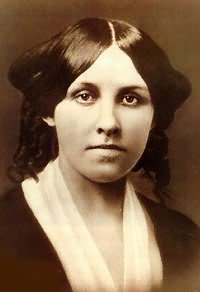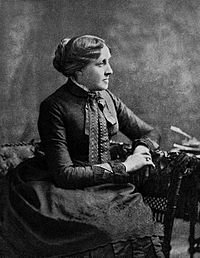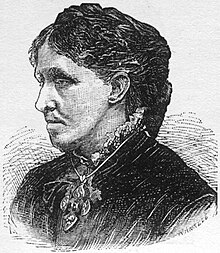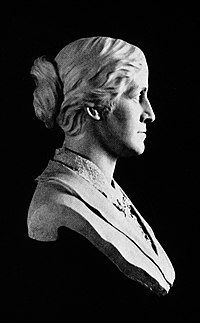
Louisa May Alcott
Louisa May Alcott | |
|---|---|
 Alcott, c. 1870
| |
| Born |
(1832-11-29)November 29, 1832 Germantown, Pennsylvania U.S. (now Philadelphia) |
| Died | March 6, 1888(1888-03-06) (aged 55) Boston, Massachusetts, U.S. |
| Resting place | Sleepy Hollow Cemetery, Concord, Massachusetts |
| Pen name | A. M. Barnard |
| Occupation | Novelist |
| Period | American Civil War |
| Genre |
|
| Subject | Young adult fiction |
| Notable works | |
| Signature | |
Louisa May Alcott (/ˈɔːlkət, -kɒt/; November 29, 1832 – March 6, 1888) was an American novelist, short story writer, and poet best known as the author of the novel Little Women (1868) and its sequels Little Men (1871) and Jo's Boys (1886). Raised in New England by her transcendentalist parents, Abigail May and Amos Bronson Alcott, she grew up among many well-known intellectuals of the day, including Margaret Fuller,Ralph Waldo Emerson, Nathaniel Hawthorne, Henry David Thoreau, and Henry Wadsworth Longfellow.
Alcott's family suffered from financial difficulties, and while she worked to help support the family from an early age, she also sought an outlet in writing. She began to receive critical success for her writing in the 1860s. Early in her career, she sometimes used pen names such as A. M. Barnard, under which she wrote lurid short stories and sensation novels for adults that focused on passion and revenge.
Published in 1868, Little Women is set in the Alcott family home, Orchard House, in Concord, Massachusetts, and is loosely based on Alcott's childhood experiences with her three sisters, Abigail May Alcott Nieriker, Elizabeth Sewall Alcott, and Anna Alcott Pratt. The novel was well-received at the time and is still popular today among both children and adults. It has been adapted for stage plays, films, and television many times.
Alcott was an abolitionist and a feminist and remained unmarried throughout her life. She also spent her life active in such reform movements as temperance and women's suffrage. She died from a stroke in Boston on March 6, 1888, just two days after her father had died.
Early life
Louisa May Alcott was born on November 29, 1832, in Germantown, which is now part of Philadelphia, Pennsylvania, on her father's 33rd birthday. She was the daughter of transcendentalist and educator Amos Bronson Alcott and social worker Abby May and the second of four daughters: Anna Bronson Alcott was the eldest; Elizabeth Sewall Alcott and Abigail May Alcott were the two youngest. As a child, she was a tomboy who preferred boys’ games. The family moved to Boston in 1834, where Alcott's father established an experimental school and joined the Transcendental Club with Ralph Waldo Emerson and Henry David Thoreau. Bronson Alcott's opinions on education, tough views on child-rearing, and moments of mental instability shaped young Alcott's mind with a desire to achieve perfection, a goal of the transcendentalists. His attitudes towards Alcott's wild and independent behavior and his inability to provide for his family created conflict between Bronson Alcott, his wife, and their daughters. Abigail resented her husband's inability to recognize her sacrifices and related his thoughtlessness to the larger issue of the inequality of sexes. She passed this recognition and desire to redress wrongs done to women on to Louisa.
| External video | |
|---|---|
|
|
In 1840, after several setbacks with the school, the Alcott family moved to a cottage on 2 acres (0.81 ha) of land, situated along the Sudbury River in Concord, Massachusetts. The three years they spent at the rented Hosmer Cottage were described as idyllic. By 1843, the Alcott family moved, along with six other members of the Consociate Family, to the Utopian Fruitlands community for a brief interval in 1843–1844. After the collapse of the Utopian Fruitlands, they moved on to rented rooms and finally, with Abigail May Alcott's inheritance and financial help from Emerson, they purchased a homestead in Concord. They moved into the home they named "Hillside" on April 1, 1845, but had moved on by 1852 when it was sold to Nathaniel Hawthorne who renamed it The Wayside. Moving 22 times in 30 years, the Alcotts returned to Concord once again in 1857 and moved into Orchard House, a two-story clapboard farmhouse, in the spring of 1858.
Alcott's early education included lessons from the naturalist Henry David Thoreau who inspired her to write Thoreau's Flute based on her time at Walden Pond. Most of the education she received though, came from her father who was strict and believed in "the sweetness of self-denial." She also received some instruction from writers and educators such as Ralph Waldo Emerson, Nathaniel Hawthorne, Margaret Fuller, and Julia Ward Howe, all of whom were family friends. She later described these early years in a newspaper sketch entitled "Transcendental Wild Oats." The sketch was reprinted in the volume Silver Pitchers (1876), which relates the family's experiment in "plain living and high thinking" at Fruitlands.
Poverty made it necessary for Alcott to go to work at an early age as a teacher, seamstress, governess, domestic helper, and writer. Her sisters also supported the family, working as seamstresses, while their mother took on social work among the Irish immigrants. Only the youngest, Abigail, was able to attend public school. Due to all of these pressures, writing became a creative and emotional outlet for Alcott. Her first book was Flower Fables (1849), a selection of tales originally written for Ellen Emerson, daughter of Ralph Waldo Emerson. Alcott is quoted as saying "I wish I was rich, I was good, and we were all a happy family this day" and was driven in life not to be poor.
In 1847, she and her family served as station masters on the Underground Railroad, when they housed a fugitive slave for one week and had discussions with Frederick Douglass. Alcott read and admired the "Declaration of Sentiments", published by the Seneca Falls Convention on women's rights, advocating for women's suffrage and became the first woman to register to vote in Concord, Massachusetts in a school board election. The 1850s were hard times for the Alcotts, and in 1854 Louisa found solace at the Boston Theatre where she wrote The Rival Prima Donnas, which she later burned due to a quarrel between the actresses on who would play what role. At one point in 1857, unable to find work and filled with despair, Alcott contemplated suicide. During that year, she read Elizabeth Gaskell's biography of Charlotte Brontë and found many parallels to her own life. In 1858, her younger sister Elizabeth died and her older sister Anna married a man named John Pratt. Alcott considered these events catalysts to breaking up their sisterhood.
Literary success
As an adult, Alcott was an abolitionist and a feminist. In 1860, Alcott began writing for the Atlantic Monthly. When the Civil War broke out, she served as a nurse in the Union Hospital in Georgetown, DC, for six weeks in 1862–1863. She intended to serve three months as a nurse, but she contracted typhoid fever and became deathly ill halfway through her service, although she eventually recovered. Her letters home—revised and published in the Boston anti-slavery paper Commonwealth and collected as Hospital Sketches (1863, republished with additions in 1869)—brought her first critical recognition for her observations and humor. This was her first book and was inspired by her army experience. She wrote about the mismanagement of hospitals, the indifference and callousness of some of the surgeons she encountered, and her own passion for seeing the war firsthand. Her main character, Tribulation Periwinkle, shows a passage from innocence to maturity and is a "serious and eloquent witness". Her novel Moods (1864), based on her own experience, was also promising.
After her service as a nurse, Alcott's father wrote her a heartfelt poem titled "To Louisa May Alcott. From her father". The poem describes how proud her father is of her for working as a nurse and helping injured soldiers as well as bringing cheer and love into their home. He ends the poem by telling her she's in his heart for being a selfless faithful daughter. This poem was featured in the books Louisa May Alcott: Her Life, Letters, and Journals (1889) and Louisa May Alcott, the Children's Friend, which talks about her childhood and close relationship with her father.
Between 1863 and 1872, Alcott anonymously wrote at least thirty-three "gothic thrillers" for popular magazines and papers such as The Flag of Our Union; they began to be rediscovered only in 1975. In the mid-1860s she wrote passionate, fiery novels and sensational stories akin to those of English authors Wilkie Collins and Mary Elizabeth Braddon under the nom de plume A. M. Barnard. Among these are A Long Fatal Love Chase and Pauline's Passion and Punishment. Her protagonists for these books, like those of Collins and Braddon (who also included feminist characters in their writings), are strong, smart, and determined. She also produced stories for children and she did not go back to writing for adults after her childrens’ stories became popular. Other books she wrote are the novelette A Modern Mephistopheles (1877), which was published anonymously and then believed to be the work of Julian Hawthorne, and the semi-autobiographical novel Work (1873).
Catherine Ross Nickerson credits Alcott with creating one of the earliest works of detective fiction in American literature, preceded only by Edgar Allan Poe's "The Murders in the Rue Morgue" and his other Auguste Dupin stories, with the 1865 thriller "V.V., or Plots and Counterplots." Alcott published the story anonymously and it concerns a Scottish aristocrat who tries to prove that a mysterious woman has killed his fiancée and cousin. The detective on the case, Antoine Dupres, is a parody of Poe's Dupin who is less concerned with solving the crime than in setting up a way to reveal the solution with a dramatic flourish.
Alcott became even more successful with the first part of Little Women: or Meg, Jo, Beth and Amy (1868), a semi-autobiographical account of her childhood with her sisters in Concord, Massachusetts, which the Roberts Brothers published. When Alcott returned to Boston following her travels in Europe, she became an editor at a magazine, Merry's Museum. There she met Thomas Niles, who encouraged the writing of Part I of the novel by asking her to create a book especially for girls. Part II, or Part Second, also known as Good Wives (1869), followed the March sisters into adulthood and marriage. Little Men (1871) detailed Jo's life at the Plumfield School she founded with her husband Professor Bhaer at the conclusion of Part Two of Little Women. Lastly, Jo's Boys (1886) completed the "March Family Saga".
In Little Women, Alcott based her heroine "Jo" on herself. However, Jo marries at the end of the story, whereas Alcott remained single throughout her life. She explained her "spinsterhood" in an interview with Louise Chandler Moulton, "I am more than half-persuaded that I am a man's soul put by some freak of nature into a woman's body.... because I have fallen in love with so many pretty girls and never once the least bit with any man.” However, Alcott's romance while in Europe with the young Polish man Ladislas "Laddie" Wisniewski was detailed in her journals but then deleted by Alcott herself before her death. Alcott identified Laddie as the model for Laurie in Little Women. Likewise, each of her characters seems to have parallels with people from Alcott's life—from Beth's death mirroring Lizzie's to Jo's rivalry with the youngest, Amy, as Alcott felt a rivalry for (Abigail) May, at times. Though Alcott never married, she did take in May's daughter, Louisa, after May's untimely death in 1879, caring for little "Lulu" for the next eight years.
In addition to drawing on her own life during the development of Little Women, Alcott also took influence from several of her earlier works including "The Sisters' Trial," "A Modern Cinderella," and "In the Garret." The characters within these short stories and poems, in addition to Alcott's own family and personal relationships, inspired the general concepts and bases for many of the characters within Little Women and the author's subsequent novels.
Little Women was well-received, with critics and audiences finding it to be a fresh, natural representation of daily life suitable for many age groups. An Eclectic Magazine reviewer called it "the very best of books to reach the hearts of the young of any age from six to sixty". With the success of Little Women, Alcott shied away from the attention and would sometimes act as a servant when fans would come to her house.
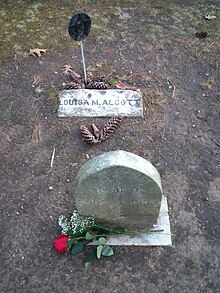
Along with Elizabeth Stoddard, Rebecca Harding Davis, Anne Moncure Crane, and others, Alcott was part of a group of female authors during the Gilded Age who addressed women's issues in a modern and candid manner. Their works were, as one newspaper columnist of the period commented, "among the decided 'signs of the times'".
Louisa May Alcott was inducted into the National Women's Hall of Fame in 1996.
Later years
In 1877, Alcott was one of the founders of the Women's Educational and Industrial Union in Boston. After her youngest sister May died in 1879, Louisa took over the care of her niece, Lulu, who was named after Louisa. Alcott suffered chronic health problems in her later years, including vertigo. She and her earliest biographers attributed her illness and death to mercury poisoning. During her American Civil War service, Alcott contracted typhoid fever and was treated with a compound containing mercury. Recent analysis of Alcott's illness suggests that her chronic health problems may have been associated with an autoimmune disease, not mercury exposure. However, mercury is a known trigger for autoimmune diseases as well. An 1870 portrait of Alcott does show her cheeks to be quite flushed, perhaps with the "butterfly rash" across cheeks and nose which is often characteristic of lupus, but there is no conclusive evidence available for a firm diagnosis.
Alcott died of a stroke at age 55 in Boston, on March 6, 1888, two days after her father's death. She is buried in Sleepy Hollow Cemetery in Concord, near Emerson, Hawthorne, and Thoreau, on a hillside now known as "Authors' Ridge". Her niece Lulu was only eight years old when Louisa died. She was cared for by Anna Alcott Pratt, then reunited with her father in Europe and lived abroad until her death in 1976.
Louisa frequently wrote in her journals about going on long walks and runs. She challenged prevailing social norms regarding gender by encouraging her young female readers to run as well.
The Alcotts' Concord, Massachusetts home, Orchard House (c. 1650), where the family lived for 25 years and where Little Women was written and set in 1868, has been a historic house museum since 1912, and pays homage to the Alcotts by focusing on public education and historic preservation. Her Boston home is featured on the Boston Women's Heritage Trail.
Selected works
The Little Women series
- Little Women, or Meg, Jo, Beth and Amy (1868)
- Part Second of Little Women, or "Good Wives", published in 1869; and afterward published together with Little Women.
- Little Men: Life at Plumfield with Jo's Boys (1871)
- Jo's Boys and How They Turned Out: A Sequel to "Little Men" (1886)
Novels
- The Inheritance (1849, unpublished until 1997)
- Moods (1865, revised 1882)
- The Mysterious Key and What It Opened (1867)
- An Old Fashioned Girl (1870)
- Will's Wonder Book (1870)
- Work: A Story of Experience (1873)
- Beginning Again, Being a Continuation of Work (1875)
- Eight Cousins or The Aunt-Hill (1875)
- Rose in Bloom: A Sequel to Eight Cousins (1876)
- Under the Lilacs (1878)
- Jack and Jill: A Village Story (1880)
As A. M. Barnard
- Behind a Mask, or a Woman's Power (1866)
- The Abbot's Ghost, or Maurice Treherne's Temptation (1867)
- A Long Fatal Love Chase (1866; first published 1995)
Published anonymously
- A Modern Mephistopheles (1877)
Short story collections for children
-
Aunt Jo's Scrap-Bag (1872–1882). (66 short stories in six volumes)
- 1. "Aunt Jo's Scrap-Bag"
- 2. "Shawl-Straps"
- 3. "Cupid and Chow-Chow"
- 4. "My Girls, Etc."
- 5. "Jimmy's Cruise in the Pinafore, Etc."
- 6. "An Old-Fashioned Thanksgiving, Etc."
- Lulu's Library (1886–1889) A collection of 32 short stories in three volumes.
- Flower Fables (1849)
- On Picket Duty, and other tales (1864)
- Morning-Glories and Other Stories (1867) Eight fantasy stories and four poems for children, including: *"A Strange Island", (1868); * "The Rose Family: A Fairy Tale" (1864), "A Christmas Song", "Morning Glories", "Shadow-Children", "Poppy's Pranks", "What the Swallows did", "Little Gulliver", "The Whale's story", "Goldfin and Silvertail".
- Kitty's Class Day and Other Stories (Three Proverb Stories), 1868, (includes "Kitty's Class Day", "Aunt Kipp" and "Psyche's Art")
- Spinning-Wheel Stories* (1884). A collection of 12 short stories.
- The Candy Country (1885) (One short story)
- May Flowers (1887) (One short story)
- Mountain-Laurel and Maidenhair (1887) (One short story)
- A Garland for Girls (1887). A collection of seven short stories.
- The Brownie and the Princess (2004). A collection of ten short stories.
Other short stories and novelettes
- Hospital Sketches (1863)
- Pauline's Passion and Punishment (1863)
- Thoreau's Flute (1863)
- My Contraband, first published as The Brothers (1863)
- Doctor Dorn's Revenge (1868)
- La Jeune; or, Actress and Woman (1868)
- Countess Varazoff (1868)
- The Romance of a Bouquet (1868)
- A Laugh and A Look (1868)
- Perilous Play (1869)
- Lost in a Pyramid, or the Mummy's Curse
- Transcendental Wild Oats (1873) A short piece about Alcott's family and the Transcendental Movement.
- Silver Pitchers, and Independence: A Centennial Love Story (1876)
- A Whisper in the Dark (1877)
- Proverb Stories (1882)
- Comic Tragedies (1893, posthumous)
In popular culture
Little Women inspired film versions in 1933, 1949, 1994, 2018, and 2019. The novel also inspired television series in 1958, 1970, 1978, and 2017, anime versions in 1981 and 1987, and a 2005 musical. . Little Women also inspired a BBC Radio 4 version in 2017.
Little Men inspired film versions in 1934, 1940, and 1998. This novel also was the basis for a 1998 television series.
Other films based on Alcott novels and stories are An Old-Fashioned Girl (1949), The Inheritance (1997), and An Old Fashioned Thanksgiving (2008). In 2009 PBS produced an American Masters episode titled "Louisa May Alcott – The Woman Behind 'Little Women' ". In 2016 a Google Doodle of the author was created by Google artist Sophie Diao.
A dramatized version of Alcott appeared as a character in the television series Dickinson, in the episode "There's a Certain Slant of Light," which premiered on November 1, 2019. Alcott was portrayed by Zosia Mamet.
Bibliography
- Shealy, Daniel, ed. (2005). Alcott in Her Own Time: A Biographical Chronicle of Her Life, Drawn from Recollections, Interviews, and Memoirs by Family, Friends and Associates. Iowa City, Iowa: University of Iowa Press. ISBN 0-87745-938-X.
- Cheny, Ednah D., ed. (1889). Louisa May Alcott, Life, Letters, and Journals. Boston. ISBN 978-1518656934.
- Madeleine Stern Louisa May Alcott (Normal, Okla. 1950 and London 1952).
- Majorie Worthington Miss Alcott of Concord: A Biography (Doubleday 1958).
- Atlantic's Brief lives: A Biographical Companion to the Arts, edited by Louis Kronenberger, Assoc. Ed. Emily Morison Beck, Little Brown & Co. 1965.
Further reading
- Cheever, Susan (2006). American Bloomsbury: Louisa May Alcott, Ralph Waldo Emerson, Margaret Fuller, Nathaniel Hawthorne, and Henry David Thoreau: Their Lives, Their Loves, Their Work. New York: Simon & Schuster. ISBN 978-0-7432-6461-7.
- Eiselein, Gregory; Phillips, Anne K., eds. (2001). The Louisa May Alcott Encyclopedia. Greenwood Press; online in ebrary, also available in print ed. ISBN 0-313-30896-9. OCLC 44174106.
- Elbert, Sarah. A Hunger for Home: Louisa May Alcott and Little Women (Temple UP, 1984).
- LaPlante, Eve (2012). Marmee & Louisa: The Untold Story of Louisa May Alcott and Her Mother. Free Press. ISBN 978-1-451-62066-5.
- Larson, Rebecca D. (1997). White Roses: Stories of Civil War Nurses. Gettysburg, PA: Thomas Publications. ISBN 1577470117. OCLC 38981206.
- MacDonald, Ruth K. (1983). Louisa May Alcott. Twayne. ISBN 0-8057-7397-5.
- Matteson, John (2007). Eden's Outcasts: The Story of Louisa May Alcott and Her Father. Norton. ISBN 978-0-393-05964-9. This book won the Pulitzer Prize for Biography or Autobiography in 2008.
- Meigs, Cornelia (1968). Invincible Louisa: The Story of the Author of Little Women. Little, Brown and Company. ISBN 978-0316565943.
- Myerson, Joel; Shealy, Daniel; Stern, Madeleine B. (1987). The Selected Letters of Louisa May Alcott. Little, Brown. ISBN 0-316-59361-3.
- Myerson, Joel; Shealy, Daniel; Stern, Madeleine B. (1989). The Journals of Louisa May Alcott. Little, Brown. ISBN 0-316-59362-1.
- Paolucci, Stefano. Da Piccole donne a Piccoli uomini: Louisa May Alcott ai Colli Albani, "Castelli Romani," LVII, n. 6, nov.–dec. 2017, pp. 163–175.
- Reisen, Harriet (2009). Louisa May Alcott: The Woman Behind Little Women. ISBN 978-0-805-08299-9. OCLC 316514238. This book was the basis for a PBS documentary directed by Nancy Porter.
- Saxton, Martha (1977). Louisa May: A Modern Biography of Louisa May Alcott. Houghton Mifflin. ISBN 0-395-25720-4.
- Seiple, Samantha (2019). Louisa on the Front Lines: Louisa May Alcott in the Civil War. New York: Seal Press, Hachette Book Group. ISBN 978-1-58005-804-9.
External links
|
Library resources about Louisa May Alcott |
| By Louisa May Alcott |
|---|
| External video | |
|---|---|
|
|
Sources
- Works by Louisa May Alcott in eBook form at Standard Ebooks
- Works by Louisa May Alcott at Project Gutenberg
- Works by Louisa May Alcott at Project Gutenberg Australia
- Works by or about Louisa May Alcott at Internet Archive
-
Works by Louisa May Alcott at LibriVox (public domain audiobooks)

- Works by Louisa May Alcott at Online Books Page
- Index entry for Louisa May Alcott at Poets' Corner
- Bibliography (including primary works and information on secondary literature – critical essays, theses and dissertations)
Archival materials
- Guide to Louisa May Alcott papers, MS Am 800.23 at Houghton Library, Harvard University
- Guide to Louisa May Alcott additional papers, 1839–1888, MS Am 2114 at Houghton Library, Harvard University
- Guide to Louisa May Alcott additional papers, 1845–1945, MS Am 1817 at Houghton Library, Harvard University
- Guide to Louisa May Alcott additional papers, 1849–1887, MS Am 1130.13 at Houghton Library, Harvard University
- Guide to Louisa May Alcott papers, MSS 503 at L. Tom Perry Special Collections, Brigham Young University
- Madeline B. Stern Papers on Louisa May Alcott, MSS 3953 at L. Tom Perry Special Collections, Brigham Young University
- Carolyn Davis collection of Louisa May Alcott at the University of Maryland Libraries
Other
- Louisa May Alcott: The Woman Behind ‘Little Women’ – American Masters documentary (PBS)
- The Louisa May Alcott Society A scholarly organization devoted to her life and works.
- Louisa May Alcott, the real woman who wrote Little Women. Documentary materials.
- Obituary, New York Times, March 7, 1888, Louisa M. Alcott Dead
- Minneapolis Tribune, March 7, 1888, Obituary: Miss Louisa M. Alcott
- Encyclopædia Britannica, Louisa May Alcott
- Louisa May Alcott's Orchard House Louisa May Alcott's Orchard House historic site in Concord, MA.
- Norwood, Arlisha. "Louisa Alcott". National Women's History Museum. 2017.
- Matteson, J. (November 2009). Little Woman; The devilish, dutiful daughter Louisa May Alcott. Humanities, 30(6), 1–6.
- Louisa May Alcott s Orchard House. (n.d.). Retrieved March 20, 2018
- Hooper, E. (September 23, 2017). Louisa May Alcott: A Difficult Woman Who Got Things Done. Retrieved March 20, 2018,
- Powell, K. (n.d.). Louisa May Alcott Family Tree and Genealogy – ThoughtCo.. Retrieved March 20, 2018
- Louisa M. Alcott Dead – archive.nytimes.com. (March 7, 1888). Retrieved March 20, 2018
- Alcott: 'Not The Little Woman You Thought She Was'. (December 28, 2009). Retrieved March 20, 2018
- Raga, S. (November 29, 2017). 10 Little Facts About Louisa May Alcott. Retrieved March 20, 2018, National Women's Hall of Fame
| Novels |
|
|
|---|---|---|
| Short works |
|
|
| Miscellany |
|
|
| Places | ||
| Family |
|
|
| People | ||
| Related |
|
|
| Film | |
|---|---|
| TV series |
|
| Other media |
|
| Trilogy | |
| Related |
|
| International | |
|---|---|
| National | |
| Academics | |
| Artists | |
| People | |
| Other | |
